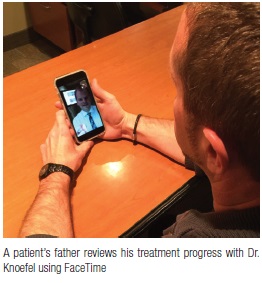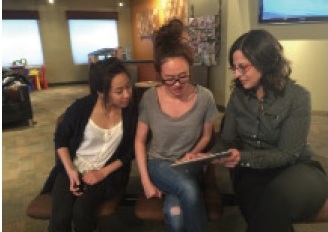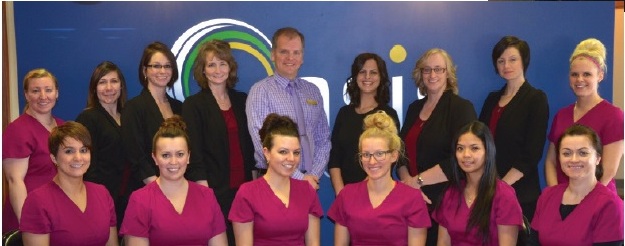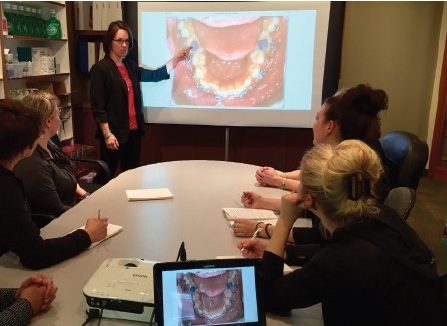Orthodontic opus
 What can you tell us about your background?
What can you tell us about your background?
The youngest of three children, I was born and raised in a small town outside of Montreal. My parents had recently im-migrated to Canada from Germany. Thanks to them, I was raised speaking three languages (German, English, and French), a tremendous enrichment that I was able to pass on to my four children. My parents’ discipline, unconditional love, and devotion to friends and family were inspirational, to say the least, and created the ideal environment for us to thrive. Piano, organ, singing, theater, and public speaking essentially defined my formative years.
Why did you decide to focus on orthodontics?
Science and art have characterized my identity, as well as a constant desire to communicate and interact with people. I couldn’t possibly pick a career in the arts, as I would have had to give up my passion for sciences. Similarly, picking a science career that suppressed my creativity would have been out of the question. Finally, having experienced treatment myself as a teenager, I immediately sensed that orthodontics would provide the balance between art, science, and human interaction that I was seeking.
How long have you been practicing, and what systems do you use?
I began practicing in the spring of 1999. Oasis Orthodontics is patient-centered, meaning my goal is to personalize care based upon each patient’s individual needs. Shared decision-making with a patient, in combination with scientific evidence, drives my approach to care. Furthermore, my team is committed to continuous improvement initiatives, which promote learnings that are applied to ameliorate patient care.
What training have you undertaken?
My training can be conveniently divided into two phases. First, my formal professional training (“fact-based knowledge”) began at the dental school at McGill University, and I graduated on the Dean’s Honor List in 1995. I completed a 1-year multidisciplinary hospital residency at the Montreal Children’s Hospital before moving to sunny Alberta. In the spring of 1999, I obtained my Master of Science in Orthodontics from the University of Alberta.
Second, my “action-based” learning occurs every day in my practice. There is no doubt that our patients, parents, and team members teach us every day if we only take the time to listen and observe. My training, therefore, is continuous. I devote at least 1 full day each week to re-evaluating my patients’ treatment progress. By taking a full set of progress photos of my patients at least every 4 months and re-analyzing them on a daily basis away from the chairside, I have been literally humbled by the wealth of information they provide.
Our practice culture at Oasis Orthodontics can be summarized as that of a learning organization. We have monthly in-practice training sessions where we discuss patient histories and use our findings to enhance our clinical skills, streamline care protocols and, most importantly, improve patient care throughout their journey at our practice.
Who has inspired you?
Just as the arts and sciences have defined my identity, I have drawn inspiration from visionaries in both fields. The composer, Johann Sebastian Bach, laid the foundation for Western music. To this day, his works are recognized not only as musical chefs d’oeuvres (masterpieces), but as scientific masterpieces as well. Ludwig van Beethoven’s symphonies, especially the Ninth, are not only beautiful, but they inspire passion in a manner that is unrivalled by any other composer. It is no accident that his Ode to Joy was selected as the anthem of the European Union.
Although I am grateful to the plethora of teachers and mentors who have ignited my passion for knowledge, there is one who has impacted me the most professionally. Dr. Rohit Sachdeva embodies the essence of the 21st century Renaissance man. Yet, surprisingly, many of his contributions to the betterment of the profession and of patient care remain unrecognized. I can only give him tribute by sharing the lessons I have learned from him. In summary, these are to have the courage to demonstrate humility and servitude, the courage to be curious, and last, but not least, the courage to embrace and learn from failure.
What is the most satisfying aspect of your practice?
A common vision and a common set of values in an environment that allows open discussion. At Oasis Orthodontics, we thrive on divergent thinking. This applies to the doctors, the staff, and the patients alike. We are all working together to seek the truth.
Professionally, what are you most proud of?
There exists no greater pride than to earn patient loyalty and to see them glow with a beautiful smile.
What do you think is unique about your practice?
 There are two primary aspects of Oasis Orthodontics that make us unique. The first is our multilingual, multi-ethnic team. Between the two doctors, we speak five languages. Croatian, Dutch, Vietnamese, Russian, Ukrainian, and French are spoken by the staff. We pride ourselves in interacting with our patients in as many languages as possible. Ultimately, the pleasant banter among patients and team members creates joy, which is a fundamental tenet of our patient care model.
There are two primary aspects of Oasis Orthodontics that make us unique. The first is our multilingual, multi-ethnic team. Between the two doctors, we speak five languages. Croatian, Dutch, Vietnamese, Russian, Ukrainian, and French are spoken by the staff. We pride ourselves in interacting with our patients in as many languages as possible. Ultimately, the pleasant banter among patients and team members creates joy, which is a fundamental tenet of our patient care model.
The other unique characteristic at Oasis Orthodontics is how we plan and deliver care. Our treatment planning does not simply occur at a high level — extraction versus non-extraction, surgery versus non-surgery, growth modification, etc. Every patient presents to us as a unique individual. Our patients are not put on an assembly line to address their needs. They are shown the respect of a “patient of one,” a concept to which Dr. Sachdeva introduced me.
It begins with actively listening to patients, with a thorough diagnosis, including the patients’ physical and emotional health, their needs and expectations, and their lifestyle. Furthermore, the patient consultation appointment is not focused on selling care; it is about enhancing patient literacy. The design phase involves using 3D simulations to better understand the best and most creative ways to address the patient’s needs. This is followed by the planning phase, which incorporates all the processes and activities that will enable the care team to provide the most rewarding care experience for the patient in an effective and efficient way.
Also, a 3D virtual simulation is created for patients to illustrate the treatment objectives, educate them about potential risks and constraints, and help them monitor their own treatment progress. The same simulation is used for communication with referring dentists and other specialists.
To ensure that treatment remains efficient, we rely on protocols and checklists at every visit. By following these systems, chairside team members are encouraged to act as nurse practitioners rather than passive “assistants.” On numerous occasions, their attention to detail has identified problems or potential issues with patient care that were missed by the doctors.
Our goal is to have alignment completed within the first 4 months. At that time, a full set of records is obtained to perform a progress review. Any potential constraints or existing problems are successfully addressed before they are able to jeopardize treatment success.
We measure ourselves with patient surveys; we encourage patients to write to us and communicate with us. So, whether in the physical world or the virtual world, we are always in touch with them. There is no doubt that all of these things take time. But as modern orthodontic professionals, we realize that our work extends beyond the boundaries of the physical practice. Whether we are communicating with patients via webinars or treatment planning from a remote location, the physical and virtual worlds of orthodontics are playing equally important roles. They challenge the “traditional” private practice model, but we are compelled to do what is right for the patient.
What has been your biggest challenge?
Balancing family and work life. With four children involved in sports, music, and art, as well as other community activities, it has been challenging to give as much attention to all aspects of my life as I would like. My wife is a saint!
What would you have become if you had not become an orthodontist?
My career would have almost certainly been in music. When I was 17, I had the opportunity to study church music in Berlin, Germany. But the thought of moving to Europe at such a young age and giving up my passion for the sciences entirely, ultimately convinced me to pursue the direction I did.
Dr. Bharwani performs a 4-month progress review on an iPad, with two adult female patients.
The Oasis Team, with Drs. Mark Knoefel and Dolly Bharwani (back row, center, left to right)
What is the future of orthodontics and dentistry?
We are at a crucial juncture in dentistry, in general, and in orthodontics, in particular. There exists a push-pull phenomenon in society between the patient as a consumer and the patient as a recipient of healthcare. Treatment will need to become more affordable, without sacrificing quality care. As a profession, and as a specialty, we can only succeed if patient care remains our priority. We will always need technology, and our staff will need to remain highly skilled. We will need to be more vigilant in how we assess technology, however. It must be a partner in providing care, but it can never replace us and must never be perceived as such. Investment in patient education, empathy, and communication must always supersede even the most sophisticated technology.
If we are ever to sell anything, it is our skill set around diagnosis and planning care. The role of the therapeutic orthodontist will be increasingly challenged, since certain skill sets, such as wire bending, will likely become redundant in the future. The role of the virtual practice will become increasingly important, as more treatment decisions will be transferred from the chairside (where doctors tend to be attention-deficient) to the computer (where records can be analyzed thoroughly). If we are not agile and resilient, the future of orthodontics as a specialty itself will be at stake. Collaborative relationships between dental specialists in multi-doctor centers will become increasingly common, with the patient as the hub.
Staff member leading one of the monthly in-practice training sessions
Dr. Knoefel treatment planning in his home office
What are your top tips for main-taining a successful practice?
One word: investment. Investing in planning, in patient care, and in the community. Quality care implies:
- Treatment when and where it is needed
- Personalized care
- Immediate response to a patient’s needs
- Patient safety
One’s goal should never be a satisfied patient; it should be a loyal patient.
The new patient consult is not a selling episode. It is an opportunity to actively listen and participate with patients in defining their care needs. The word “doctor” comes from the Latin “docere,” “to teach.” As such, it is our duty to educate our patients — not to act as “providers” for our “customers.”
What advice would you give to budding orthodontists?
Devote your energies to anticipating your patients’ needs. Success is a journey, not an outcome.
What are your hobbies, and what do you do in your spare time?
Traveling with my wife and children is my favorite pastime. It not only is an opportunity to recharge, but also enhances our sensibility to different cultures and ethnicities. In my spare time, I am heavily involved in my children’s sporting and community activities, including coaching soccer for the last 3 years. I am looking forward to the day that I will be able to spend more time playing music again.
Stay Relevant With Orthodontic Practice US
Join our email list for CE courses and webinars, articles and mores






